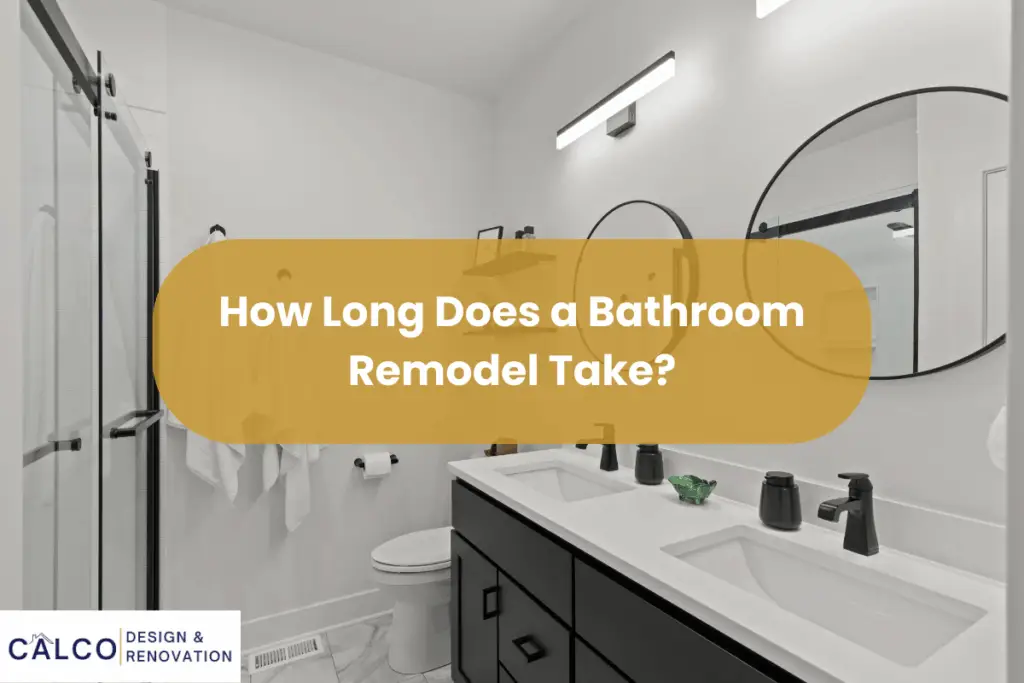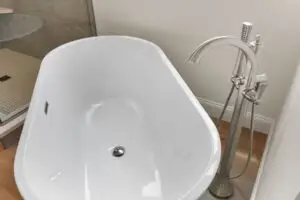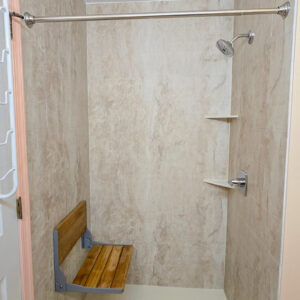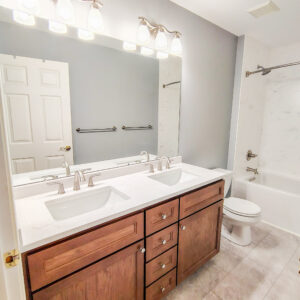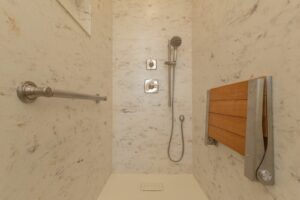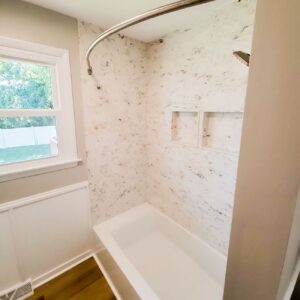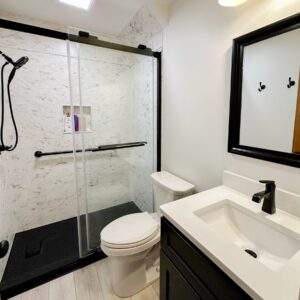You finally made the decision — that tired old bathroom has to go.
The cracked tiles, wobbly vanity, and retro-pink bathtub have had their run.
After months of saving ideas and planning your dream design, you’re ready to bring it to life.
Naturally, one of the first questions that comes up is: How long will this take?
Friends and family may have their own stories — some quick, some drawn out — but every remodel is different.
The good news?
A well-planned bathroom renovation doesn’t have to drag on.
Most remodels follow a fairly predictable timeline — and knowing where your project fits can help you plan with confidence.
In this guide, we’ll break down what determines how long a bathroom remodel takes, ways to avoid common delays, and how to set realistic expectations for a smooth, stress-free project.
The Short Answer — National Averages
The average bathroom remodel time in the United States is between 3 and 8 weeks from demolition to completion. The actual duration depends on the size of the space, the complexity of the work, and the materials involved.
Here’s how those averages break down.
Small Bathroom Remodels
For a small bathroom remodel, the average time is about 3–4 weeks. These projects usually involve straightforward updates such as replacing fixtures, updating tile, and repainting walls. With less square footage, each stage moves more quickly and there’s less waiting between steps.
Standard Full Bathroom Renovations
A standard full bathroom renovation typically takes 4–6 weeks. This timeline covers removing old finishes, upgrading plumbing and electrical systems, installing new fixtures, and retiling floors and walls. Even without major layout changes, inspections and material deliveries can add time to the schedule.
Large Or Complex Bathroom Projects
Extensive projects — such as expanding the footprint, relocating plumbing, adding custom cabinetry, or installing luxury features — often take 6–8 weeks. These jobs require more coordination between trades, additional inspections, and longer lead times for specialized or custom materials.
What Affects a Bathroom Remodel Timeline?
Even with a clear national average, the actual schedule for your project depends on several variables. The bathroom remodel timeline can shift based on the size of the space, the scope of work, and how many moving parts are involved. Understanding these factors up front will help you plan better, avoid surprises, and keep your renovation on track.
Bathroom Size And Scope
The overall footprint of your bathroom plays a big role in the timeline. A small bathroom remodel without plumbing changes can often be completed more quickly because there’s less demolition, tiling, and painting. Larger spaces require more labor and materials, and even small upgrades in a large bathroom can take longer due to the sheer amount of surface area to cover.
Complexity Of The Design
Changing the layout of your bathroom adds time to the schedule. Moving a shower, tub, toilet, or sink means plumbing and electrical systems need to be rerouted — sometimes involving structural work as well. The full bathroom remodel duration with layout changes can be several weeks longer than a simple “replace what’s there” renovation.
Materials And Lead Times
Material availability can speed up or slow down a bathroom remodel. In-stock items like standard tile or fixtures can be installed right away, while custom or special-order products may take weeks to arrive. If those items are critical to your project, the availability impact on the remodel schedule can be significant. Ordering materials early is one of the best ways to avoid delays.
Custom Features And Specialty Work
Adding custom cabinetry, intricate tile patterns, or luxury features like a steam shower can extend the custom bathroom renovation timeline. These elements often require highly skilled tradespeople, more detailed installation work, and extra coordination between contractors. While the results are worth it, expect the schedule to lengthen for projects with multiple custom touches.
Permits and Inspections
Many bathroom renovations require permits for plumbing, electrical, or structural changes. Waiting for approvals — and for inspectors to sign off at different stages — can add days or even weeks to your timeline. These administrative delays are often out of the contractor’s control but can be minimized by submitting permit applications early and scheduling inspections as soon as possible.
Step-By-Step Bathroom Remodel Timeline
Breaking the bathroom remodel process into clear stages makes it easier to see how the schedule comes together. While every project is unique, the following bathroom remodel process steps timeline reflects what’s typical for a professional bathroom remodel timeline from start to finish.
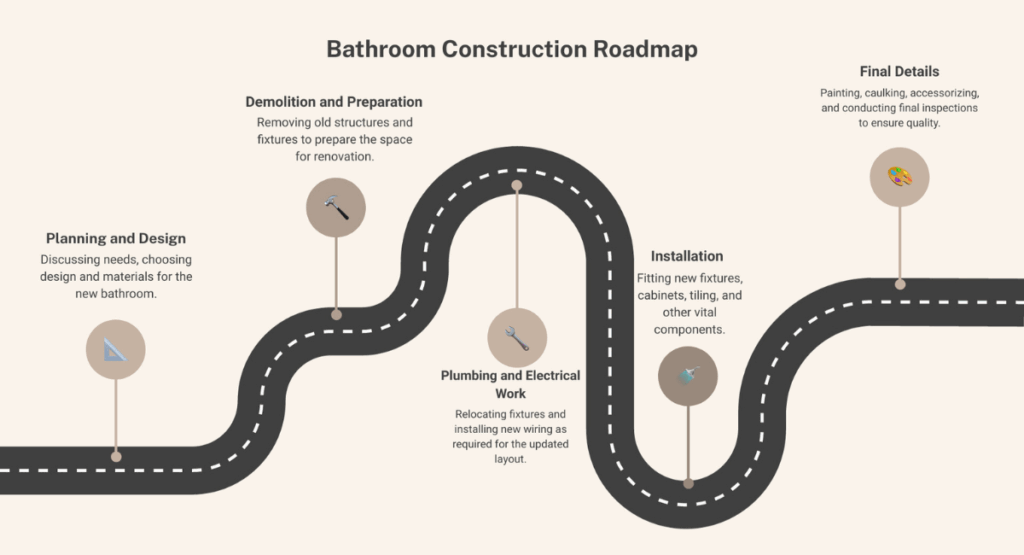
Planning & Design (1–2 Weeks)
Before any demolition begins, the planning and design phase lays the foundation for the entire project. This includes measuring the space, finalizing the layout, selecting materials, and ordering fixtures. A thorough design stage helps prevent costly changes later and ensures all materials are ready when construction starts.
Demolition (1–3 Days)
Demolition involves removing old fixtures, flooring, wall finishes, and sometimes cabinetry. For a straightforward remodel, this can be completed in a day or two. More complex projects — such as those with heavy tile removal or structural changes — may require an extra day or more.
Plumbing & Electrical Rough-In (2–5 Days)
Once the space is cleared, plumbers and electricians complete the rough-in work. This is when new pipes, wiring, outlets, and lighting circuits are installed or moved to match the updated design. Inspections often follow before the walls and floors are closed back up.
Structural Or Layout Changes (Variable)
If you’re altering the footprint of the bathroom, adding walls, or reinforcing floors, expect this step to vary in duration. Moving plumbing or electrical systems to accommodate a new layout can extend the schedule, especially if permits and inspections are required between each stage.
Flooring, Tiling, & Wall Finishes (3–7 Days)
With the rough-in work complete, the focus shifts to surfaces. This includes installing flooring, tiling walls or shower enclosures, applying grout, and finishing with paint or wallpaper. Larger spaces or intricate tile patterns can increase the time needed for this phase.
Fixtures, Lighting, & Hardware Installation (2–4 Days)
Next, the major elements of the bathroom come together — the bathtub or shower, toilet, vanity, sinks, faucets, mirrors, and lighting. Careful installation ensures everything works properly and aligns with the overall design.
Final Touches & Cleanup (1–2 Days)
The final stage covers smaller details like towel bars, shelving, caulking, and any touch-up painting. After that, the space is cleaned, inspected, and ready for use. A professional cleaning ensures no construction dust or debris is left behind.
How to Keep Your Bathroom Remodel on Schedule
Good bathroom renovation timeline planning isn’t just about knowing the average duration — it’s about taking proactive steps to prevent delays. These strategies will help you keep your bathroom remodel on track from start to finish.
Work With an Experienced Contractor
An experienced contractor does more than manage the crew — they coordinate trades, schedule inspections, and anticipate problems before they cause delays. Look for someone with a proven track record in bathroom renovations, strong references, and clear communication skills. The right professional can streamline the process and keep your project moving efficiently.
Approve Design Decisions Early
Design indecision can halt progress mid-project. Finalize your layout, finishes, and fixtures before work begins so tradespeople have a clear plan to follow. Last-minute changes can mean reordering materials, redoing work, and rescheduling inspections — all of which extend the bathroom renovation timeline unnecessarily. Early approvals keep everything aligned.
Order Materials in Advance
Material delays are one of the most common reasons bathroom projects run over schedule. Ordering tile, fixtures, and finishes well before demolition starts ensures everything is ready when needed. For custom or special-order items, confirm lead times early and build them into your project plan to avoid unnecessary downtime.
Schedule Inspections Early
Permitted work, like plumbing or electrical changes, requires inspections before moving to the next phase. Waiting for availability can easily stall the project for days. Book inspection slots as soon as your permit is approved, and coordinate with your contractor so all work is ready for review on time.

Ensure the Work Area is Accessible
Access issues can slow crews down significantly. Before work begins, clear the bathroom of personal items, ensure parking and entry are convenient for workers, and provide space for storing tools or staging materials. A well-prepared, clutter-free environment helps the team stay productive and keeps the schedule moving forward.
Communicate Frequently With Your Remodel Team
Consistent communication is key to keeping your bathroom remodel on track. Regular check-ins — whether daily texts, weekly meetings, or progress photos — help you stay informed and address issues before they snowball. A contractor who provides updates and responds promptly helps ensure the timeline stays predictable and stress-free.
Avoid Last-Minute Scope Changes
Scope changes once construction starts can cause ripple effects throughout the schedule. Adding new features or altering the layout often means extra labor, additional permits, or extended inspections. While adjustments are sometimes unavoidable, keeping them to a minimum preserves momentum and prevents your remodel from sliding weeks beyond the original plan.
Have a Contingency Plan for Delays
Even the best-planned bathroom remodels can encounter surprises — water damage, structural issues, or backordered products. Building a small buffer of extra days into your schedule allows flexibility without derailing your expectations. A contingency plan ensures small setbacks don’t create major stress or cause cascading delays.
Small vs. Large Bathroom Remodel Timelines
While the national averages provide a baseline for small bathroom remodel time and large bathroom renovation duration, the real difference comes from how size affects the workflow. Smaller bathrooms can move faster in some stages, while larger ones often require additional steps that add time to the schedule.
Time Savings in Smaller Spaces
Fewer square feet means less demolition, less tiling, and less painting — all of which can be completed faster. A compact space also reduces the time spent moving tools and materials in and out. However, the savings aren’t always huge if the project involves specialty finishes or complex plumbing work.
Extra Steps for Larger, Complex Layouts
A large bathroom renovation often includes more fixtures, longer plumbing runs, and bigger areas to tile or finish. These projects may also involve multiple work zones — like a separate tub, shower, and water closet — each requiring its own installation sequence. More space means more coordination between trades, which naturally extends the duration.
Balancing Size With Design Goals
The size of your bathroom should help guide your design ambitions. In smaller spaces, high-impact details like custom cabinetry or elaborate tile patterns can add days to the schedule despite the reduced footprint. In larger bathrooms, the layout may allow multiple trades to work at the same time, slightly offsetting the added scope.
The Hidden Challenges in Any Size Bathroom
Surprises can happen in any remodel, regardless of size. In small bathrooms, issues like water damage behind walls can still halt progress. In large bathrooms, delays often come from waiting on custom pieces or specialized fixtures. Building extra time into your plan helps keep expectations realistic for both scenarios.
FAQs About Bathroom Remodel Timelines
Homeowners often have specific questions about how long a bathroom remodel will take and what can affect the schedule. Here are clear, expanded answers to the most common queries so you can plan with confidence and set realistic expectations for your project.
How Long Does a Small Bathroom Remodel Take?
Typically 3–4 weeks, though this can vary based on the scope of work, material availability, and whether plumbing or electrical systems are being altered. Smaller spaces reduce the amount of demolition, tiling, and painting required, but intricate designs, premium materials, or custom cabinetry can add several days to the schedule.
What Is the Average Bathroom Remodel Time?
On average, bathroom remodels take 3–8 weeks from demolition to final cleanup. Projects with a straightforward scope, standard fixtures, and readily available materials often finish in under a month, while large-scale renovations with layout changes, custom features, or permit requirements land toward the longer end of that range.
Can a Bathroom Remodel Be Done in Two Weeks?
It’s possible, but only under ideal circumstances — such as a small space, no major plumbing or electrical changes, in-stock materials, and a highly efficient crew. Even then, there’s little room for unexpected issues, so a two-week bathroom remodel requires near-perfect planning and execution to be realistic.
How Do Material Delays Affect a Bathroom Renovation Timeline?
Material delays are one of the most common causes of schedule overruns. Backordered tile, fixtures, or cabinetry can add days or even weeks to your project. Ordering all materials early, verifying delivery dates, and choosing alternative products if delays arise can help keep the bathroom renovation timeline on track.
Does Changing the Layout Make a Remodel Take Longer?
Yes. Relocating plumbing lines, electrical wiring, or structural elements adds labor and complexity, requires additional inspections, and can introduce scheduling gaps between trades. These layout changes often extend a remodel by one to three weeks compared to projects that keep the existing configuration intact.
How Long Does It Take to Remodel a Bathroom Without Moving Plumbing?
Without plumbing changes, most bathrooms can be remodeled in 3–5 weeks. This saves time by eliminating the need to reroute pipes, cut into floors or walls, and coordinate extra inspections. Crews can focus on demolition, finishes, and fixture installation without the delays that come from layout modifications.
What Are the Steps in a Professional Bathroom Remodel?
The process generally follows a set sequence: planning and design, demolition, plumbing and electrical rough-in, structural or layout work (if needed), flooring and wall finishes, fixture and lighting installation, final details, and cleanup. Each stage builds on the one before it, so delays in early steps can affect the overall schedule.
How Can I Speed Up My Bathroom Remodel Without Sacrificing Quality?
The best approach is to plan thoroughly before work begins — finalize your design, select all materials, and hire a contractor experienced in managing timelines. Order products in advance, schedule inspections early, and avoid last-minute changes that require rework. Good preparation minimizes downtime and keeps quality high.
Is CalCo’s Timeline Faster Than the National Average?
Yes. CalCo’s bathroom remodel time estimate can be in as little as 5 days, which is faster than the U.S. average of 3–8 weeks. Our streamlined scheduling, in-house coordination, and strong relationships with local suppliers help minimize downtime and deliver high-quality results without the extended wait times many homeowners experience.
Make the Wait Worth It
If you’ve been wondering “how long does a bathroom remodel take,?” the answer is shorter than you think when the process is done right. At CalCo Design & Renovation, our streamlined approach blends speed with craftsmanship, so every day of your remodel brings you closer to a space you love. Call us today and let’s get your project started.

